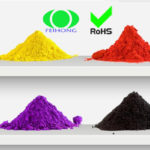Powder Coating Application
now browsing by tag
Coating Korea Exhibition and Tech Seminar Opens in BEXCO, Busan

The 2017 International Coating, Adhesive, and Film Fair(hereafter stated as Coating Korea) is set to open in the BEXCO Exhibition Hall 1 in Busan this coming August 30th to September 1st. Coating Korea is a industry specialized exhibition that showcases the latest technology and products in coating, adhesive, and films, and is the greatest coating exhibition in the nation. The exhibition has opened every March in Songdo Convensia starting from 2010, and the International Coating, Adhesive, and Film Fair, whichRead More …
Configuration of powder coating application equipment
There are many ways to apply powder coating materials; however, the material that is to be applied must be of a compatible type. For instance, if the method of application is fluidized bed. then the powder coating material must be a fluidized bed grade, Conversely, if the method of application is electrostatic spray, then the powder material must be an electrostatic spray grade. Once the material is correctly selected, then the method of application is selected by part design andRead More …
Powder coating market in Southeast Asia is expected to continue to grow

According to a recent study, powder coating market in South East Asia in 2015 values 222.7 million dollars, and in 2022 it is expected to reach US $295.2 million, a compound annual growth rate of 2016-2022 will be 4.2%. Indonesia is the largest powder coating market of South East Asia and will maintain this position in the next 6 years. Powder coating market growth in this region is mainly due to advances in technology and construction, appliance, automotive, furniture, ACERead More …
Hazardous chemicals in powder coating activities
Triglycidylisocyanurate (TGIC) TGIC is classified as a hazardous chemical and is commonly used in powder coating activities. It is: a skin sensitiser toxic by ingestion and inhalation genotoxic capable of causing serious eye damage. You should check SDSs and labels to determine if the powder coat colors you are using contains TGIC. Electrostatic powder coating containing TGIC are applied by electrostatic process.Workers who may come into direct contact with TGIC powder coatings include persons: filling hoppers manually spraying powder paint,Read More …
Two common types of ventilation in spray painting
Two common types of ventilation used in spray painting are: Local exhaust ventilation captures the overspray and solvent vapour as close to the source of release as possible by drawing the contaminants into a capture hood. They should be fitted with a particulate filtration system to filter overspray. Wherever possible, local exhaust ventilation should be used when a spray booth cannot be used. It may be necessary to use it in combination with other control measures. Information on local exhaustRead More …
Maintenance of spray equipment
You should ensure that the plant and spray equipment used in spray painting or powder coating activities is well maintained, operational and clean. This includes: regular visual checks of equipment and plant, including engineering controls and ventilation systems regular monitoring and testing of ventilation flow rates regular servicing of all equipment and plant procedures for reporting and repairing faulty equipment records of servicing, maintenance, repair and testing of plant and equipment should be kept for future reference. When undertaking maintenanceRead More …
RAL K7
RAL English RAL 1000 Green beige RAL 1001 Beige RAL 1002 Sand yellow RAL 1003 Signal yellow RAL 1004 Golden yellow RAL 1005 Honey yellow RAL 1006 Maize yellow RAL 1007 Daffodil yellow RAL 1011 Brown beige RAL 1012 Lemon yellow RAL 1013 Oyster white RAL 1014 Ivory RAL 1015 Light ivory RAL 1016 Sulfur yellow RAL 1017 Saffron yellow RAL 1018 Zinc yellow RAL 1019 Grey beige RAL 1020 Olive yellow RAL 1021 Rape yellow RAL 1023 Traffic yellow RAL 1024 Ochre yellowRead More …
Conditions for Dust Explosions
During powder coating application , the conditions for dust explosions must be paid attention highly to avoid any problem occur . A number of conditions must exist simultaneously for a dust explosion to occur. The dust must be combustible (as far as dust clouds are concerned, the terms “combustible”, “flammable” and “explosible” all have the same meaning and could be used interchangeably). The dust must be dispersed (forming a cloud in air). The dust concentration must be within the explosibleRead More …
How to maintain metallic effect powder coating
How to maintain metallic effect powder coating Metallic effects arise through light reflection, absorption and mirror effect of the metallic effect pigments contained in the paint. These metallic powders can be used in both exterior and interior environments. The cleanability and suitability of the powder,for an environment or end use, starts with the colour selection process. In certain instances the powder manufacturer may propose the application of a suitable clear topcoat.The cleaning of metallic effect powder coated surfaces is inRead More …
Powder Coat Aluminum – Aluminum Powder Coating
Powder Coat Aluminum Comparing with conventional paint,powder coating is much more durable and is commonly applied on substrate parts that will be long term exposed to tough environments.That maybe worthwhile to DIY if there are lots of aluminum parts around you required for powder coating.It is no more difficult to buy a powder coating gun on your market than spraying paint . Instructions 1.Clean the part completely,removing off any paint,dirt or oil . Make sure that any components not to be coated (such as O-rings or seals) have been removed. 2.Mask any area of the part not be coated using high-temperature tape. For blocking off holes, purchase reusable silicone plugs that press into the hole. Mask large areas by taping on a piece of aluminum foil. 3.Set the part on a wire rack or hang it from a metal hook. Fill the gun’s powder container with powder no more than 1/3 full. Connect the gun’s ground clip to the rack. 4.Spray the part with powder, coating it evenly and completely. For most parts, only one coat will be necessary. 5.Preheat the oven to bake. Insert the part into the oven being careful not to bump the part or touch the coating. Consult the documentation for your coating powder about necessary temperature and curing time. 6.Remove the part from the oven and let it cool. Remove any masking tape or plugs. Notes: Make sure the gun is plugged into a properly grounded outlet. The gun cannot work without a ground connection.

 D5 Creation
D5 Creation